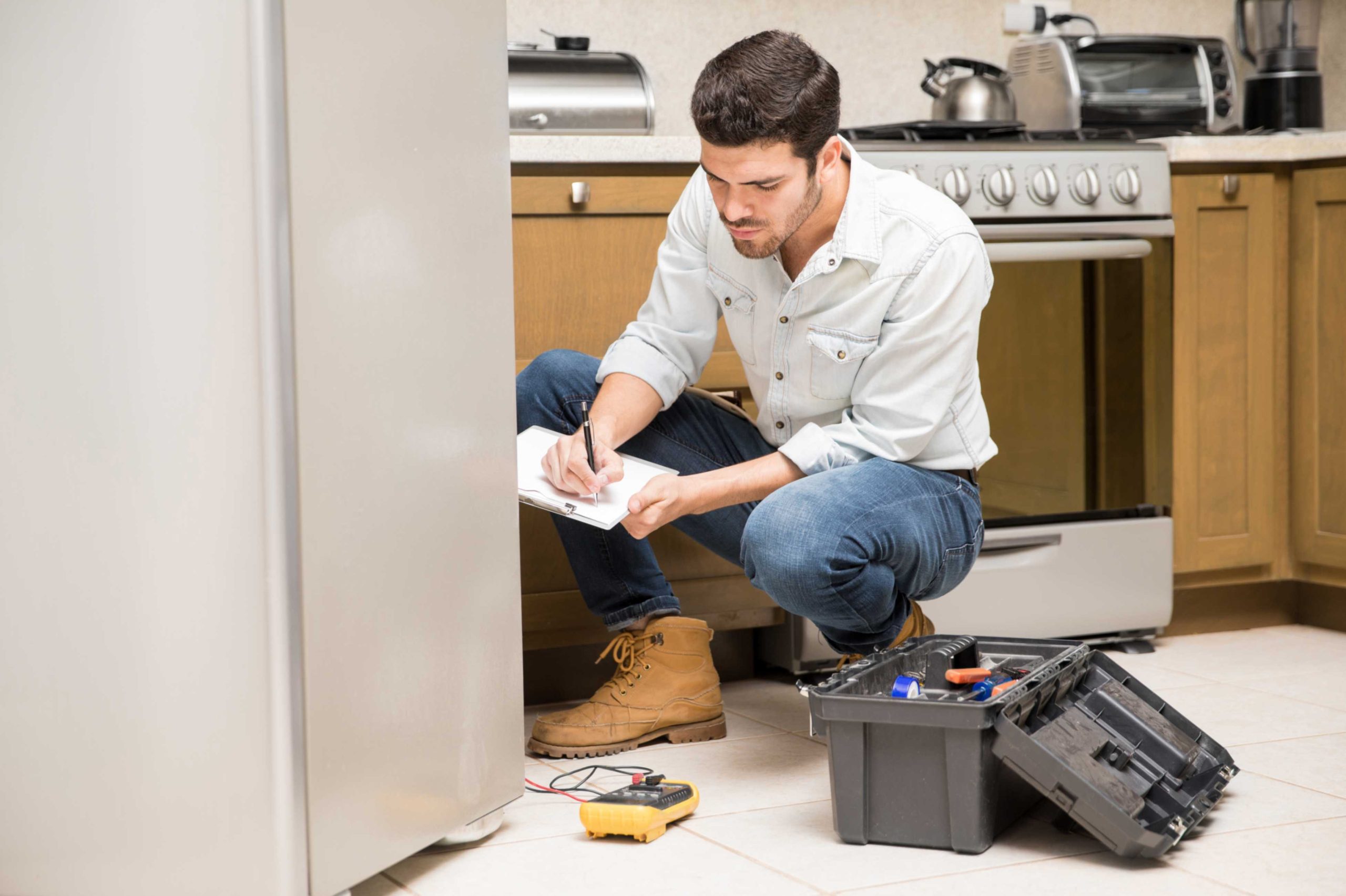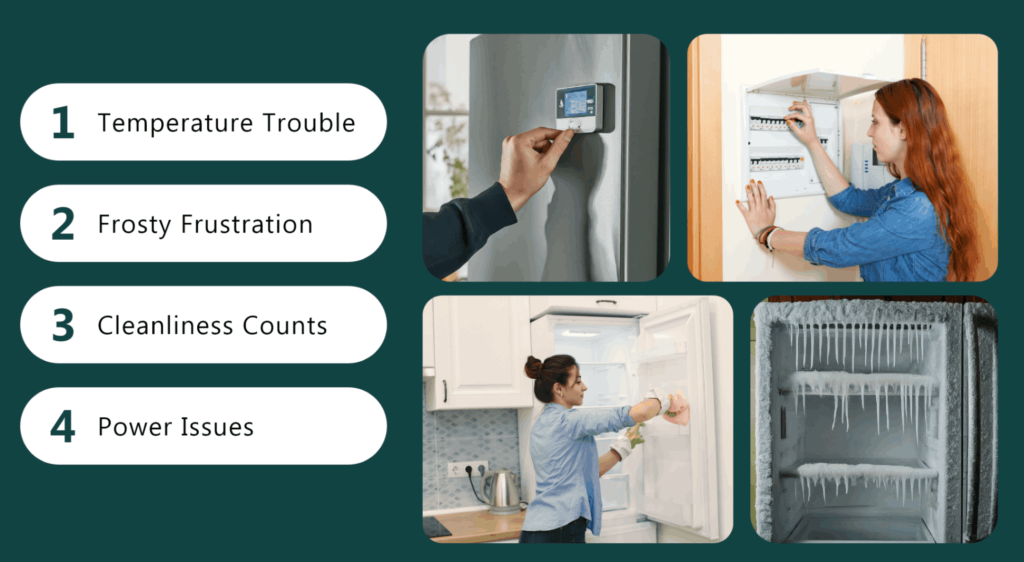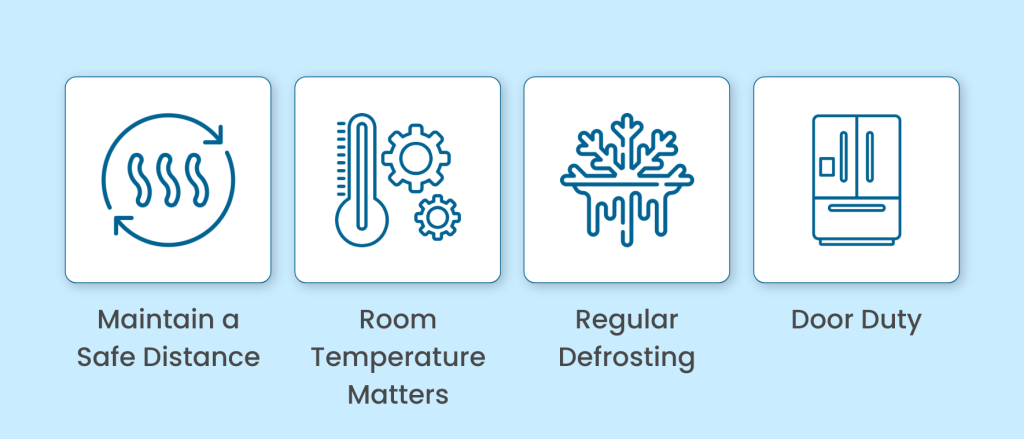 Last updated: August 6th, 2024
Last updated: August 6th, 2024
How to Fix a Freezer That's Not Working?

A malfunctioning freezer can be a source of significant stress. Visions of thawed and spoiled food dance in your head, and the cost of replacing everything can be daunting. But fret not! Before you resign yourself to a freezer full of mush, there are some troubleshooting steps you can take to get your frosty friend back in action.
Diagnosis is The Key
Before diving into repairs, identify the culprit behind your freezer’s woes. Here are some common issues and solutions:

– Temperature Trouble
1. Check the Thermostat:
- Setting Adjustment: Ensure that the thermostat is set to the correct temperature, usually between 0°F (-18°C) and 5°F (-15°C) for a freezer. Adjust it if necessary.
- Thermostat Malfunction: If the setting is correct, but the temperature is still off, the thermostat might be faulty. Test it with a multimeter to see if it’s sending the proper signals to the compressor.
2. Door Seals:
- Seal Integrity: Inspect the door seals for wear, cracks, or gaps. A poor seal can cause cold air to escape, preventing the freezer from maintaining the correct temperature.
- Seal Cleaning: Dirty seals can sometimes hinder proper closing. Clean the seals with a damp cloth and mild detergent to ensure they are debris-free.
3. Air Circulation:
- Blocked Vents: Ensure food items do not block air vents inside the freezer. Proper air circulation is crucial for maintaining an even temperature.
- Overloading: Avoid overloading the freezer, which can obstruct air circulation and strain the cooling system.
– Frosty Frustration
1. Defrost Cycle Issues:
- Automatic Defrost: If your freezer has an automatic defrost function, ensure it works correctly. A malfunctioning defrost timer, heater, or thermostat can cause frost build-up.
- Manual Defrost: For manual defrost freezers, defrost regularly to prevent excessive frost build-up, which can hinder cooling efficiency.
2. Defrost Drain:
- Clogged Drain: Check the defrost drain for clogs, which can cause water to accumulate and freeze. Clean the drain using a solution of hot water and baking soda.
3. Ice Build-Up:
- Door Left Open: Leaving the freezer door open for extended periods can cause frost to build up. Ensure the door closes completely every time.
- Seal Condition: As mentioned earlier, ensure the door seals are in good condition to prevent warm air from entering and causing frost.
– Cleanliness Counts
1. Condenser Coils:
- Coil Cleaning: Dirty condenser coils can reduce the freezer’s efficiency. Locate the coils (usually at the back or beneath the unit) and clean them with a coil brush or vacuum cleaner to remove dust and debris.
2. Evaporator Fan:
- Fan Inspection: The evaporator fan circulates cold air throughout the freezer. Check if the fan is working correctly. It might need to be replaced if it’s making strange noises or not running.
3. Interior Cleanliness:
- Regular Cleaning: Clean the inside of the freezer regularly to remove spilled food or ice build-up. This helps maintain optimal performance and hygiene.
– Power Issues
1. Power Supply:
- Outlet Check: Ensure the freezer is plugged into a working electrical outlet. Test the outlet by plugging in another appliance.
- Power Cord: Inspect the power cord for any signs of damage. A frayed or damaged cord can cause power issues and should be replaced immediately.
2. Circuit Breaker:
- Breaker Check: Check the circuit breaker to ensure it hasn’t tripped. Reset the breaker if necessary.
3. Compressor:
- Compressor Function: The compressor is essential for the freezer’s cooling function. Listen to the sound of the compressor running. It might need professional servicing or replacement if it’s not running or making unusual noises.
- Relay and Overload Protector: These components start the compressor and protect it from overheating. If the compressor isn’t starting, these parts might need to be tested and replaced if found faulty.
If you’ve tried these solutions and your freezer remains uncooperative, it might be time to call a professional appliance repair technician. They can diagnose more complex problems and recommend repairs or replacements.
Can a Home Warranty Help?
A home warranty is a service contract that provides repair or replacement coverage for major home systems and appliances that break down due to normal wear and tear. Freezers are a common inclusion among the many household appliances covered. However, many companies also offer freezers as an add-on coverage. So, when your freezer breaks down, a home warranty can be valuable, providing financial relief and convenience.
Here’s how a home warranty can help in fixing a broken freezer:
- Cost Savings
One of the primary benefits of a home warranty is the potential for significant cost savings. Repairing or replacing a freezer can be expensive, ranging from a few hundred to several thousand dollars, depending on the extent of the damage and the type of freezer. A home warranty typically covers repairs or replacement costs minus a service fee or deductible, saving homeowners from unexpected, large out-of-pocket expenses.
- Access to Professional Technicians
Home warranty companies have a network of pre-screened, qualified technicians. When your freezer breaks down, the warranty provider will arrange for a technician to assess and fix the problem. This ensures that repairs are handled by experienced individuals, reducing the likelihood of further issues caused by improper repair work.
- Convenience and Speed
Dealing with appliance breakdowns can be stressful and time-consuming. Home warranty companies streamline the process by handling all the logistics. Once you file a claim, the company will schedule a service visit, usually within a short period. This means you don’t have to spend time researching and contacting repair services yourself.
- Comprehensive Coverage
Home warranties typically cover a wide range of issues that can affect your freezer, from mechanical and electrical failures to problems with the cooling system. This comprehensive coverage ensures that most potential problems are addressed, providing peace of mind that your freezer will be restored to working order without additional costs.
- Predictable Budgeting
With a home warranty, you pay an annual or monthly premium that covers repairs and replacements for your freezer and other appliances. This predictability allows for better budgeting and financial planning, as significant, unexpected repair bills won’t blindside you.
Top 4 Preventative Measures to Keep Your Freezer Running Smoothly
With a few simple preventative measures, you can ensure your freezer operates efficiently. Even if you have a home warranty for your freezer, maintenance is crucial.

So, let’s explore the top four tips to keep your freezer in great shape.
1. Maintain a Safe Distance
One of the most common mistakes people make with their freezers is overcrowding. While it might seem like a good idea to pack as much as possible into the space available, this can hinder your freezer’s performance. Here’s why:
- Air Circulation: Freezers rely on proper air circulation to maintain a consistent temperature. When items are crammed, air cannot circulate effectively, leading to uneven cooling. Some parts of your freezer may become too warm, causing food to thaw slightly and refreeze, affecting texture and safety.
- Efficiency: A crowded freezer has to work harder to keep everything cold, leading to increased energy consumption and potential wear and tear on the appliance.
Tip: Arrange your freezer contents so that air flows freely. Leave some space between items and avoid blocking any vents. Use baskets or bins to keep things organized and ensure better airflow.
2. Room Temperature Matters
Where you place your freezer can significantly impact its efficiency and longevity. Your freezer should be kept in a cool, well-ventilated area. Here’s what to consider:
- Avoid Heat Sources: Placing your freezer near ovens, stoves, or direct sunlight forces it to work harder to maintain a low temperature. This can lead to increased energy consumption and strain on the appliance’s cooling system.
- Ventilation: Ensure there is adequate space around your freezer for ventilation. This helps dissipate heat generated by the freezer’s motor and compressor, improving overall efficiency.
Tip: Position your freezer in a cool, shaded part of your home, away from heat sources. Ensure there is at least a few inches of space around the back and sides of the freezer to allow for proper ventilation.
3. Regular Defrosting
Even if your freezer has an automatic defrost function, it’s beneficial to perform manual defrosting occasionally, especially if you notice excessive frost buildup. Here’s why:
- Efficiency: Frost buildup can insulate the cooling coils, making it harder for the freezer to maintain the desired temperature. This not only decreases efficiency but also increases energy consumption.
- Space: Frost takes up valuable space in your freezer, reducing the room for your food.
Tip: Schedule a manual defrost every few months or whenever you notice a significant amount of frost buildup. To defrost, unplug the freezer, remove all contents, and let the ice melt naturally. Clean the interior before plugging it back in and restocking your food.
4. Door Duty
The freezer door is a critical component in maintaining the internal temperature. Each time you open the door, cold air escapes, and warm air enters, forcing the freezer to work harder to return to the set temperature. Here’s how to minimize this impact:
- Limit Open Time: Try to open the freezer door only when necessary and close it as quickly as possible. Plan before opening the door to grab everything you need in one go.
- Seal Check: Regularly check the door seal for any signs of wear or damage. A faulty seal allows cold air to escape even when the door is closed, making your freezer less efficient.
Tip: Develop the habit of closing the freezer door promptly. Ensure the door seals are clean and in good condition. If you notice any damage or the door doesn’t close tightly, replace the seal to maintain proper insulation.
Conclusion
Following the troubleshooting and maintenance tips under each category, you can narrow down the cause of your freezer's woes and potentially get it back to its frosty best without needing professional help. Remember, if you're uncomfortable with any of these steps or the problem persists, it's always best to contact your home warranty provider so they can send a qualified appliance repair technician.
related articles
 Discover First American Home Warranty Locations and What You Need to Know About Their Cover.
Discover First American Home Warranty Locations and What You Need to Know About Their Cover.
 Reviews of Home Warranty Companies Show You How to Determine If Your Home Is Covered
Reviews of Home Warranty Companies Show You How to Determine If Your Home Is Covered











